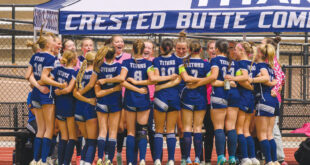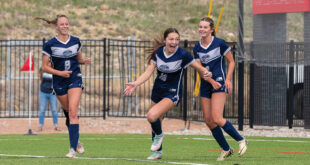“I’m just so stoked to be on the podium”
No one really knew what to expect when they gathered for the first-ever Winter Youth Olympic Games in Innsbruck, Austria. The Youth Olympic Games began with the first Summer Youth Olympic Games in Singapore in 2010. The games are the brainchild of the International Olympic Committee and, more accurately, the president of the IOC, Jacques Rogge.
The concept is to provide a forum for teenagers, ages 14 to 19, to showcase their talents in international athletic competition modeled after the Olympic Games. The larger message of these games is to encourage young people to become involved in physical pursuits to better both their bodies and their minds.
Unlike the adult version of the games, each country that qualifies for an event is limited to bringing only one representative for that event. Additionally, since this is the first winter games of its kind, not all of the events found in the standard Olympic Games are included. At the same time, some of the newly included Olympic sports were included for the first time in an IOC-sanctioned event. One of these new events is halfpipe skiing, and the sole competitor from the United States of America selected by the U.S. Ski Team was Crested Butte’s own Aaron Blunck.
Aaron travelled to Innsbruck with other members of the U.S. delegation by way of Munich, Germany on January 9, 2012. Upon arrival, he was notified by the IOC that due to too much snow up in Kühtai (pronounced koo-tie), the highest mountain resort in Austria at 2020 meters and 28 kilometers from downtown Innsbruck, training would not take place until the venue was more thoroughly prepared. That proved to be advantageous to Aaron, as it allowed him to adjust to the eight-hour time difference between Colorado and Austria. The IOC, Kühtai Resort personnel, and the Austrian Army worked steadfastly to prepare the venue for training on Thursday, January 12, 2012.
Following Friday’s snowy and windy training, Aaron and the 12 other competitors from around the globe boarded a bus for a return to Innsbruck and the inaugural opening ceremony of the Winter Youth Olympic Games. It was at this spectacular event that the athletes, coaches, parents, and spectators learned not only the magnitude of this event, but the importance that the IOC put on these games.
The opening ceremony was a beautifully choreographed event attended by not only the president of Austria, but Mr. Rogge himself. The ceremony was a terrific blend of the history of the Olympics in Innsbruck, which hosted both the 1964 and 1976 Winter Games, while combining the new school attitude that is representative of the athletes competing. All of the greatest Austrian winter athletes took part in the event, with the culmination being the lighting of the Olympic cauldron by one of the greatest downhill ski racers, Franz Klammer. It was truly a magical affair.
With the ceremony complete, it was time to get serious about the games. The day after the opening ceremonies, Saturday, January 14, the halfpipe skiing qualifications round took place. Aaron stood tall during the qualifications putting himself in third place right behind Beau-James Wells of New Zealand and Kai Mahler of Switzerland.
“Third is a perfect place to be heading into the finals,” said Aaron’s coach Elana Chase. “You have confidence, there is less pressure, and you are within striking distance of the win.”
With the qualifications complete, the athletes returned to the Olympic Village in Innsbruck to rest and prepare for Sunday’s final.
Sunday was another beautiful, sunny day up in Kühtai with calm winds and temperatures in the 20s. The women’s finals in halfpipe skiing and snowboarding started the afternoon session and saw American Arielle Gold from Steamboat take the silver medal in snowboard halfpipe. With the sun returning from its hour-long sojourn behind one of the majestic Austrian peaks that comprise the Kühtai ski resort, it was game on for both men’s halfpipe skiing and snowboarding. The event organizers had chosen to run the finals sequentially with the skiers taking their first runs followed by the snowboarders and repeating that order for the second runs.
Blunck had nailed his run in training, but while wowing the crowd with the first double of the event, a double flair, Aaron landed in seventh-place after the first run. Kai Mahler of Switzerland followed Blunck in the run order and nailed his run for a score of 95.
“Kai’s coach saw my double flair in training and told Kai he needed to throw his own double to win,” Blunck said. “I saw Kai go and mad props to him because he went so big, and so perfect.”
Mahler’s double cork 1260 and combination of spins and grabs sealed the gold medal for the Swiss athlete, but there were still two other podium spots.
After the snowboarders completed their first runs, which saw American Ben Ferguson from Bend, Oregon go off and seal the gold medal, it was time for the freeskiers’ second run. The fourth-place qualifier Lauri Kivari of Finland cleaned up his first run and put down a stylish run for a score of 90. Aaron dropped in immediately after the Finn and set his sights on the podium. He began his run with a huge, crowd-cheering double flair, this time stomping the landing. The first hit was followed with a left cork 900 tail grab, right cork 900 tail grab, left 540 mute grab, right 1080 true tail, switch 720 to flair. The judges awarded the technical run with a score of 87.50, putting Aaron on the podium.
“It was definitely the technicality of my run that got me to the medals podium,” Blunck stated. “A lot of other athletes had good style on their runs and put a lot of style into their tricks. But I focused on going bigger with more technicality and less style.”
The podium was not solidified, though, as New Zealand’s Beau-James Wells still had the opportunity to unseat Aaron. Beau’s run fell just short, leaving him in fourth place.
“I was nervous at the bottom with Beau still to go,” said Aaron. “Beau is my friend, but when I saw him miss his Japan grab in the middle of his run, I knew the podium was mine. I’m just so stoked to be on the podium.”
With the first International Olympic Committee halfpipe skiing competition complete, it is evident that the IOC made the correct decision to include this event in the Olympic program. If the quality of skiing by these 15 and 16-year-old athletes is any indication, the 2014 halfpipe skiing competition in Sochi, Russia should be fabulous.
 The Crested Butte News Serving the Gunnison Valley since 1999
The Crested Butte News Serving the Gunnison Valley since 1999

